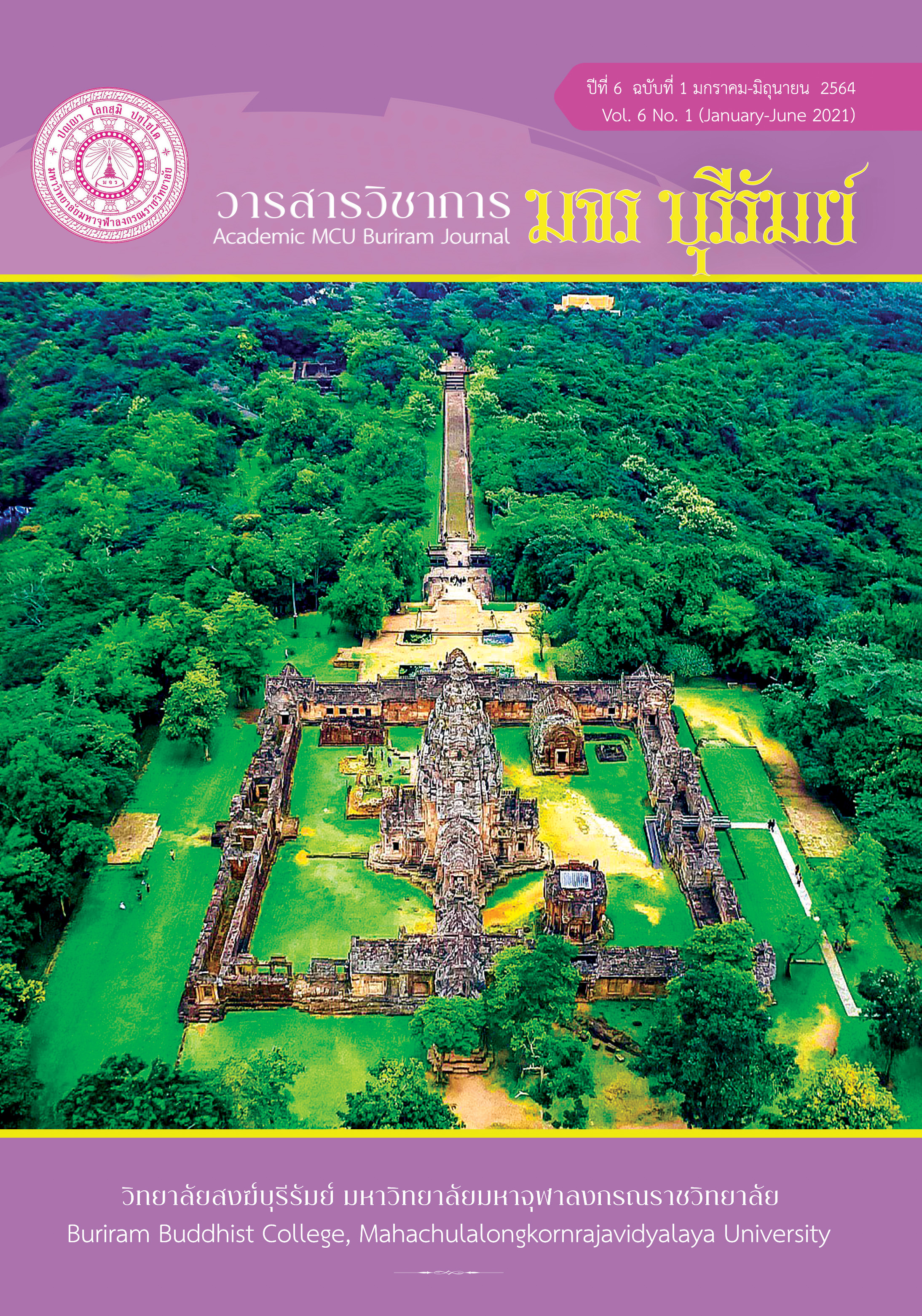ศาสนาและวัฒนธรรม: การใช้ประโยชน์จากอัตลักษณ์ของฐานทรัพยากร การท่องเที่ยวจังหวัดสุรินทร์
คำสำคัญ:
ศาสนาและวัฒนธรรม, การใช้ประโยชน์, อัตลักษณ์, ฐานทรัพยากรการท่องเที่ยวบทคัดย่อ
บทความวิจัยนี้ มีวัตถุประสงค์ 1) เพื่อศึกษาอัตลักษณ์ทรัพยากรการท่องเที่ยวของหมู่บ้านท่องเที่ยวจังหวัดสุรินทร์ 2) เพื่อศึกษาการพัฒนาทรัพยากรการท่องเที่ยวในหมู่บ้านท่องเที่ยวจังหวัดสุรินทร์ 3) เพื่อศึกษาการสร้างมูลค่าเพิ่มของทรัพยากรการท่องเที่ยวในหมู่บ้านท่องเที่ยวจังหวัดสุรินทร์ และ 4) เพื่อศึกษาการใช้ประโยชน์อัตลักษณ์ทรัพยากรการท่องเที่ยวในหมู่บ้านท่องเที่ยวจังหวัดสุรินทร์ เป็นการวิจัยเชิงคุณภาพ กลุ่มผู้ให้ข้อมูลหลัก มี 41 รูป/คน เครื่องมือการวิจัย คือ แบบบันทึกเอกสาร แบบสังเกต แบบสัมภาษณ์ แบบบันทึกสนทนากลุ่มย่อย วิเคราะห์ข้อมูลแบบพรรณนา ผลการวิจัยพบว่า 1) อัตลักษณ์ทรัพยากรการท่องเที่ยวจังหวัดสุรินทร์ คือ หมู่บ้านช้าง ผ้าไหม ประเกือม กลุ่มปราสาทขอม และแหล่งท่องเที่ยวทางพระพุทธศาสนา มีทรัพยากรการท่องเที่ยวสำคัญ คือ ลักษณะที่อยู่อาศัย อาหารพื้นบ้าน ผลิตภัณฑ์ท้องถิ่น วัฒนธรรมประเพณี กิจกรรมท่องเที่ยว สถานที่ท่องเที่ยว ศาสนสถาน และศาสนวัตถุ 2) การพัฒนาทรัพยากรการท่องเที่ยวในหมู่บ้านท่องเที่ยวจังหวัดสุรินทร์ คือ การสร้างเอกลักษณ์เฉพาะตัว นำเสนอสร้างสรรค์ น่าสนใจ จัดรูปแบบผลิตภัณฑ์บรรจุภัณฑ์มีคุณภาพ เตรียมความพร้อมเข้าสู่การรับรองมาตรฐาน สร้างผลิตภัณฑ์ผลิตซ้ำได้ในปริมาณและคุณภาพใกล้เคียงกัน หาช่องทางตลาดผลิตภัณฑ์ และอนุรักษ์เมนูอาหารท้องถิ่น 3) การสร้างมูลค่าเพิ่มทรัพยากรการท่องเที่ยวในหมู่บ้านท่องเที่ยวจังหวัดสุรินทร์ คือ ตอบความต้องการลูกค้า ผลิตภัณฑ์ที่เป็นจุดขาย วัตถุดิบ กระบวนการผลิต บรรจุภัณฑ์ ช่องทางจัดจำหน่าย การสร้างแบรนด์ และการเข้าถึงผู้บริโภค และ 4) การใช้ประโยชน์อัตลักษณ์ทรัพยากรการท่องเที่ยวหมู่บ้านท่องเที่ยวจังหวัดสุรินทร์ ด้านเศรษฐกิจ เป็นแหล่งรายได้เงินตราต่างประเทศ สร้างรายได้ เกิดการอนุรักษ์ศิลปวัฒนธรรมประเพณี ด้านการเมือง สร้างภาพพจน์ที่ดีกับคนในชาติและต่างชาติ ด้านสังคม เกิดการอนุรักษ์วัฒนธรรมประเพณี เกิดการพัฒนาภูมิประเทศ สภาพแวดล้อมให้ดีและสวยงาม
เอกสารอ้างอิง
วรรณา วงษ์วานิชฬ. (2546). ภูมิศาสตร์การท่องเที่ยว, กรุงเทพฯ: สำนักพิมพ์มหาวิทยาลัยธรรมศาสตร์.
ศิริวรรณ เสรีรัตน์ และคณะ. (2554). หลักการตลาด, หลักการตลาด. กรุงเทพฯ: ธีระฟิล์มและไซแท็กซ์.
สุดาพร กุณฑลบุตร. (2557). หลักการตลาดสมัยใหม่. พิมพ์ครั้งที่ 5. กรุงเทพฯ: โรงพิมพ์แห่งจุฬาลงกรณ์มหาวิทยาลัย.
สำนักงานพัฒนาชุมชนจังหวัดสุรินทร์. (2562). ของดีวิถีสุรินทร์ โครงการเพื่อส่งเสริมความเป็นผู้ประกอบการชุมชน. กรุงเทพฯ: โรงพิมพ์ทาราครีเอทีป.
สำนักเสริมสร้างความเข้มแข็งชุมชน กรมพัฒนาชุมชน. (2561). เกณฑ์การประกวดชุมชนท่องเที่ยว OTOP นวัตวิถี. กรุงเทพฯ: บริษัท บีทีเอส เพรส จำกัด.
อภิญญา เฟื่องฟูสกุล. (2546).อัตลักษณ์ Identity การทบทวนทฤษฎีและกรอบแนวคิด. กรุงเทพฯ: คณะกรรมการสภาวิจัยแห่งชาติ.
จีรนันท์ ทองสมัคร.(2556). การท่องเที่ยวเชิงสร้างสรรค์ ทิศทางของการพัฒนาการท่องเที่ยวอย่างยั่งยืน. วารสารการบริการและการท่องเที่ยวไทย, 8(2), 91-104.
นายป่วน เจียวทอง. (18 ธันวาคม 2562). ครูภูมิปัญญาไทยรุ่นที 6 สำนักงานเลขาธิการสภาการศึกษา. บ้านเลขที่ 63 หมู่ที่ 3 บ้านโชค ตำบลเขวาสินรินทร์ อำเภอเขวาสินรินทร์ จังหวัดสุรินทร์. สัมภาษณ์.
พระสมุห์หาญ ปญฺญาธโร และคณะ. (10 ธันวาคม 2562). เจ้าอาวาสวัดป่าอาเจียง (สุสานช้าง) บ้านหนองบัว หมู่ 14 ตำบลกระโพ อำเภอท่าตูม จังหวัดสุรินทร์. สัมภาษณ์.
นายสายฟ้า ศาลางามและคณะ.10 ธันวาคม 2562). เจ้าของร้าน OTOP, บ้านหนองบัว หมู่ 14 ตำบลกระโพ อำเภอท่าตูม จังหวัดสุรินทร์. สัมภาษณ์.
พูนลาภ ทิพชาติโยธิน, (2553). Value-Added Activities เพิ่มลูกค้าด้วยกิจกรรมเพิ่มมูลค่า. http://202.183.190.2/FTPiWebAdmin/knw_pworld/image_content/85/87-89.pdf, March 2018.
สำนักงานสถิติสุรินทร์, VC 5. การสร้างมูลค่าเพิ่มให้กับผลิตภัณฑ์. <http://surin.nso.go.th/index.php?option=com_content&view=article&id=511:mindmap--otop-&catid=114&Itemid=557> June 2020.
ดาวน์โหลด
เผยแพร่แล้ว
รูปแบบการอ้างอิง
ฉบับ
ประเภทบทความ
สัญญาอนุญาต
ทัศนะและความคิดเห็นที่ปรากฏในบทความวารสารฉบับนี้ถือเป็นความรับผิดชอบของผู้เขียนบทความนั้น ไม่ถือเป็นทัศนะและความรับผิดชอบของบรรณาธิการ





